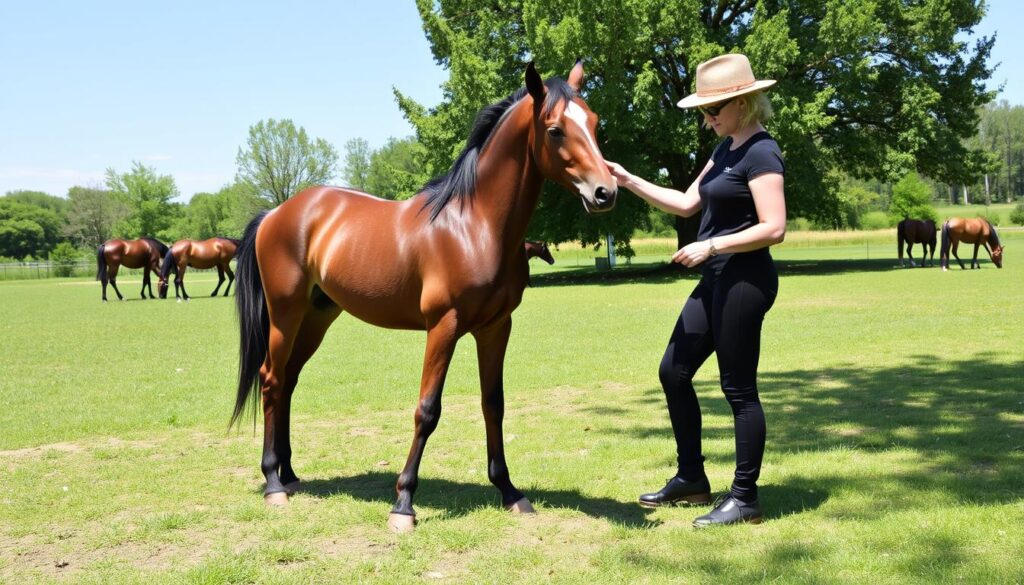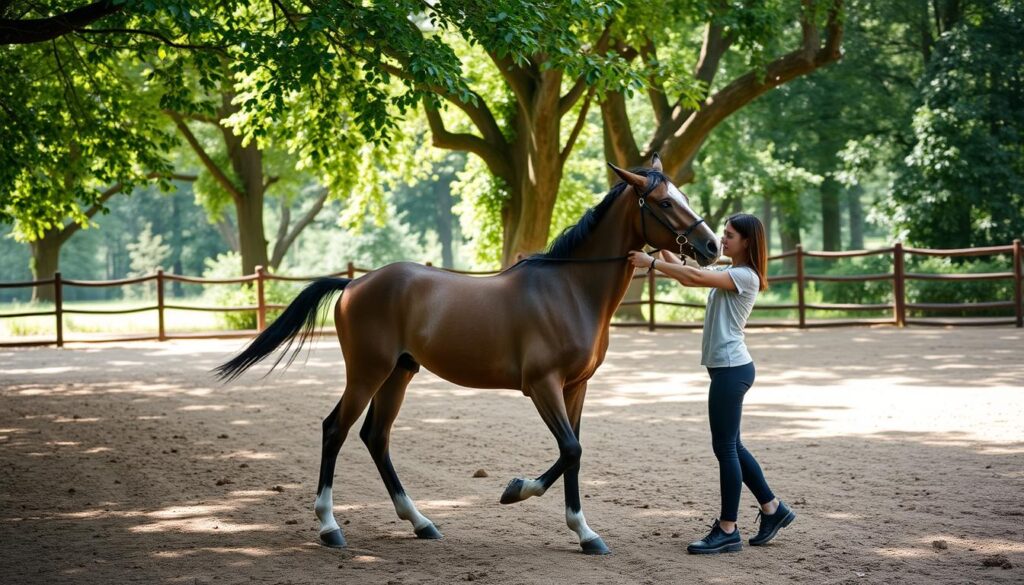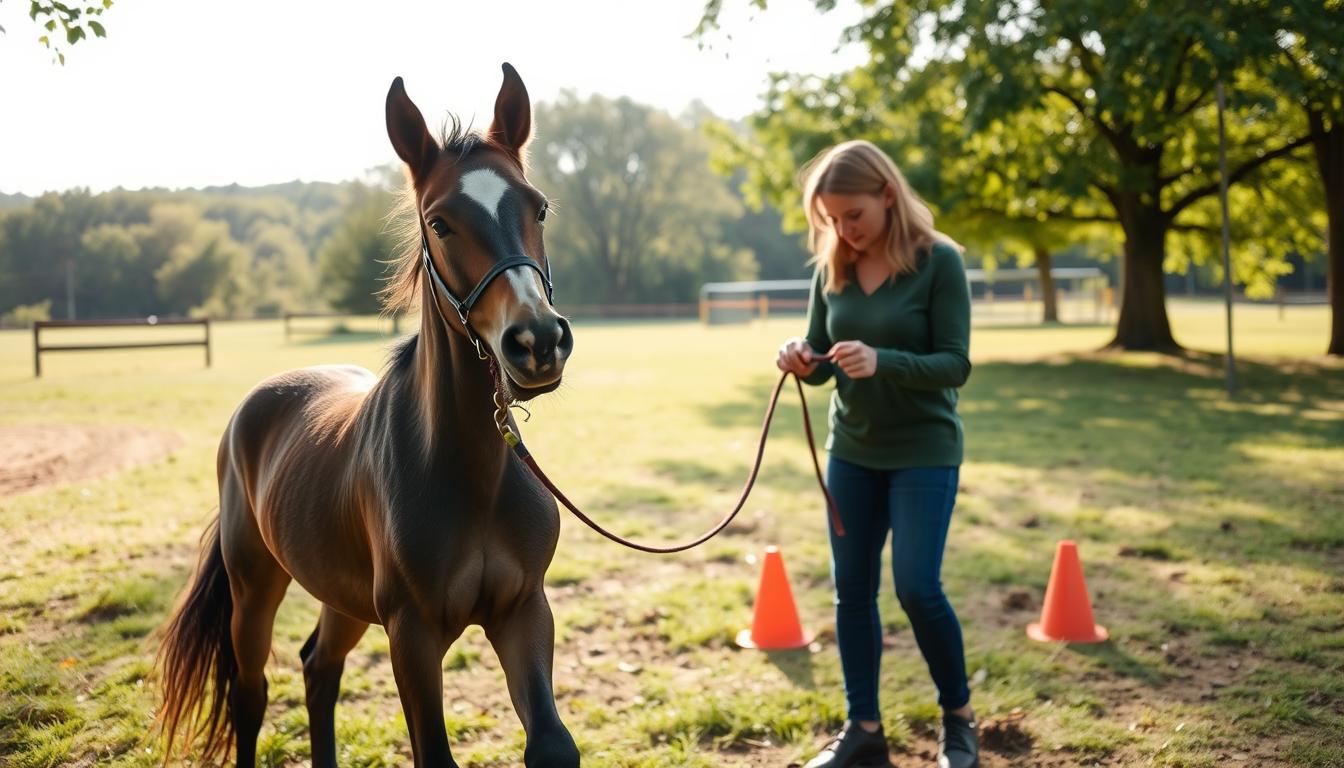Teaching young horses is key to their growth and success. Different training methods exist, but a complete approach is vital. This guide will cover various aspects of training young horses.
Training young horses means understanding their psychology and behavior. The right methods help them grow physically and mentally.
With the right training, young horses can learn fast and well. Using the best techniques and methods helps avoid bad habits. This ensures a solid base for their future. Following a detailed guide helps give young horses a great start.
Key Takeaways
- Effective training techniques for young horses are essential for their development and future performance
- Understanding horse psychology and behavior is crucial for successful training
- Using the right horse training methods can help prevent bad habits and ensure a strong foundation
- Training techniques for young horses should be comprehensive and well-structured
- Horse training methods can vary, but a thorough approach is necessary for optimal results
- Young horses can learn quickly and efficiently with the right training techniques and methods
Understanding Young Horse Psychology
Young horses have their own unique psychology. It’s key for effective training and education. Knowing their natural behaviors helps create a better training space.
Young horses go through different stages, each with its own needs. Recognizing these stages is crucial for the right training. For example, foals need gentle handling, while yearlings need structured training.
Natural Horse Behavior Patterns
Natural horse behaviors include socializing, exploring, and playing. These are vital for their growth. Trainers should encourage and support these behaviors for a balanced training program.
Development Stages in Young Horses
The development stages in young horses include:
- Foal stage (0-6 months): Focus on socialization and gentle handling
- Yearling stage (6-12 months): Introduce structured training and physical exercise
- Two-year-old stage: Continue training and introduce more complex exercises
Building Trust and Rapport
Building trust and rapport with young horses is key. Trainers should create a positive environment. Using positive reinforcement and gentle handling helps build a strong bond.
Understanding young horse psychology helps trainers create effective programs. This approach benefits both the horses and the trainers, leading to a better training environment.
| Development Stage | Characteristics | Training Focus |
|---|---|---|
| Foal | Socialization, gentle handling | Gentle handling, socialization |
| Yearling | Structured training, physical exercise | Introduction to structured training |
| Two-year-old | Continued training, complex exercises | Advanced training techniques |
Essential Safety Measures When Working with Young Horses
When it comes to equine training strategies, safety is key. Breaking in young horses comes with risks. To avoid these, wear proper gear like a helmet and gloves.
Safe equine training strategies mean knowing the horse’s body language. Look for signs of fear or anxiety, like raised ears or a tense body. Also, learn how to handle young horses safely, including leading and tying.
- Make sure the horse is halter-broken and lead-trained
- Use safe, fitting equipment like a saddle and bridle
- Work in a secure area, like an arena or paddock
By focusing on safety, you can have a positive training experience. This builds a strong, respectful bond with your horse.
Creating the Ideal Training Environment
When it comes to Horse training techniques, the environment is key. A good training space builds confidence in both the horse and the trainer. It’s important to pick a space that fits your needs, like round pens or open arenas.
When choosing a space, think about its size, footing, and equipment. Round pens are great for colt starting techniques because they’re safe and controlled. Open arenas offer more room for horses to move and exercise.
Don’t forget the basics like halters, lead ropes, and saddles. Safety barriers, like fences or gates, are also crucial. With the right setup, your young horse will become confident and well-trained.
| Training Space | Benefits | Drawbacks |
|---|---|---|
| Round Pen | Controlled and safe environment | Limited space |
| Open Arena | More space for horses to move and exercise | Less control over the environment |
Fundamental Training Techniques for Young Horses
Training young horses needs a solid foundation. This includes basic commands, setting limits, and understanding pressure and release. These steps help horses succeed in their training.
Groundwork for young horses is key. It teaches them to follow commands and get used to different tools and challenges. This groundwork builds their skills and confidence for their future careers.
- Establishing clear boundaries and communication
- Introducing basic commands and exercises
- Teaching horses to respond to pressure and release
- Developing trust and rapport between horse and trainer
By using these basic training methods and focusing on groundwork for young horses, trainers can make their horses confident and skilled. These techniques are essential for any horse, whether for competition or a strong bond with their owner.
| Technique | Description |
|---|---|
| Basic Commands | Teaching horses to respond to basic commands, such as walking, trotting, and halting |
| Groundwork | Introducing horses to various equipment and obstacles to develop their skills and confidence |
| Pressure and Release | Teaching horses to respond to pressure and release to develop their trust and rapport with the trainer |
Introduction to Groundwork Basics
Groundwork is key in young horse training. It focuses on teaching horse behavior and using effective training methods. It lays the groundwork for more complex training and builds a strong bond between humans and horses. Starting with basic leading techniques is crucial. It helps establish control and respect, vital for successful training.
Understanding the importance of horse behavior training is essential. This means teaching your horse to follow voice commands, move in circles, and respect your space. Groundwork includes:
- Leading exercises to establish control and respect
- Lunging fundamentals to teach horses to move in circles and respond to voice commands
- Ground manners training to teach young horses to stand still, yield to pressure, and respect personal space
By adding these training methods to your daily routine, you help your horse develop good manners. This lays a solid foundation for more advanced training. Always focus on horse behavior training and use positive reinforcement to encourage good behavior.

As you continue with groundwork, you’ll see big improvements in your horse’s behavior and how well they respond. By focusing on horse behavior training and using effective methods, you can create a strong and lasting bond with your horse.
| Groundwork Exercise | Benefits |
|---|---|
| Leading exercises | Establishes control and respect |
| Lunging fundamentals | Teaches horses to move in circles and respond to voice commands |
| Ground manners training | Teaches young horses to stand still, yield to pressure, and respect personal space |
Desensitization Methods and Approach
Teaching young horses is key to making them calm and confident. Desensitization helps them get over their fear of sudden movements. Training methods like systematic desensitization and counter-conditioning are used to introduce scary things slowly and safely.
Starting small is crucial when desensitizing horses. Begin by exposing them to new sights, sounds, and textures in a safe place. This helps them become less scared and more ready for new things. Teaching desensitization is important for young horses to grow up well-adjusted.
Some good ways to desensitize horses include:
- Gradual exposure to new stimuli
- Positive reinforcement training
- Counter-conditioning to associate frightening stimuli with positive outcomes
Using these training methods helps horses feel more confident and calm. Desensitization is a big part of teaching young horses. By focusing on desensitization and using the right training, owners can help their horses succeed and build a strong future.
Progressive Loading and Pressure Training
Breaking in young horses means teaching them to handle pressure and touch. This helps them get ready for riding and handling. Techniques like touch sensitivity exercises are key in this step.
Touch sensitivity exercises make horses okay with human touch. You can do this by gently touching, stroking, and massaging them. This builds trust and confidence in your presence.
As training goes on, you can add things like halters, blankets, and saddles. This helps them get used to feeling weight and pressure.
Building Tolerance Levels
It’s important to build tolerance in young horses. Start with small amounts of pressure and slowly increase it. For example, start with a light touch or soft brush.
By doing this, you help your horse get comfortable with new sensations. This builds confidence and trust, making breaking in successful.
Equipment Introduction
Introducing new equipment should be done slowly and carefully. First, let the horse get to know the equipment, like a saddle or bridle. Place it near them so they can sniff and explore.
Then, slowly introduce it to their body. This way, your horse will feel comfortable with the equipment. It also lowers the chance of fear or resistance.
Developing Physical Coordination
Physical coordination is key for young horses. It affects their future performance. To boost balance, flexibility, and body awareness, focus on colt starting techniques and training techniques for young horses. Controlled movement exercises, obstacle work, and complex tasks help a lot.
Groundwork exercises are great for coordination. They include leading, lunging, and teaching ground manners. As your horse gets better, add harder obstacles like ground poles and small jumps. For more tips, check out exercises to improve your horse’s coordination.
Developing physical coordination in young horses has many benefits. It improves balance and flexibility. It also boosts body awareness, confidence, and trust. Plus, it prepares them for advanced riding and performance.
By focusing on physical coordination and using colt starting techniques and training techniques for young horses, you set your horse up for success. This helps them reach their full potential.
First Saddling Procedures
Introducing a saddle to a young horse is a key step in its training. It needs patience, careful planning, and a good understanding of horse training methods. The aim is to make the horse comfortable with the saddle, girth, and other gear. This is the start of successful groundwork for young horses.
To start, let the horse get used to the equipment. Let it see, smell, and touch the saddle and other tack. Do this with gentle, controlled steps, slowly getting the horse used to the gear.
Equipment Familiarization
First, place the saddle and other gear near the horse. Let it get used to their presence. Reward the horse for staying calm, making it associate the gear with good things.
Mounting Block Training
After the horse gets used to the gear, it’s time for the mounting block. Teach the horse to stand still while you mount. Use words, gentle pressure, and rewards to help it learn.
By following these steps and using good horse training methods, your young horse will feel confident and comfortable. This is the start of successful groundwork for young horses and a strong base for future training.
Building Balance and Flexibility
Teaching young horses is key to their development. They need to be balanced and flexible to do well in different activities. Exercises like lateral work, bending, and transitions are important.
These activities make the horse’s core stronger and help it carry its weight evenly. Regular practice also makes the horse more flexible. It’s important to start these exercises slowly so the horse gets used to them.
Some good ways to improve balance and flexibility include:
- Lateral work, such as leg-yielding and shoulder-in
- Bending exercises, like figure-eights and serpentines
- Transitions, including walk-trot and trot-canter
By adding these exercises to training, your young horse will get better at many equestrian activities. 
| Exercise | Benefits |
|---|---|
| Lateral work | Improves balance and strengthens core |
| Bending exercises | Enhances flexibility and promotes even weight distribution |
| Transitions | Develops strength, agility, and coordination |
Always think about your horse’s comfort and safety during training. If you’re not sure about something, get help from a professional.
Advanced Ground Training Techniques
Horse owners and trainers aim to build a strong bond between horse and rider. Advanced ground training is key to refining a horse’s skills. Techniques like long-lining and lunging improve a horse’s responsiveness and balance.
Long-lining uses two long lines to guide the horse in circles or figure-eights. It prepares the horse for bit contact and enhances balance and coordination. For more on horse care, visit equine care resources.
Advanced lunging patterns introduce changes in direction and transitions. This challenges the horse and refines their skills. It requires patience, consistency, and clear communication between trainer and horse.
Key Components of Advanced Ground Training
- Long-lining skills to improve balance and coordination
- Advanced lunging patterns to challenge the horse and refine their skills
- Liberty work introduction to foster a deeper level of communication and trust
By using these advanced techniques, trainers can help horses reach their full potential. Whether you’re experienced or new, staying updated on horse training is crucial. It ensures the best outcomes for your horse.
| Technique | Benefits |
|---|---|
| Long-lining | Improves balance and coordination, prepares horse for bit contact and steering |
| Advanced lunging patterns | Challenges the horse, refines their skills, and enhances responsiveness |
| Liberty work | Fosters a deeper level of communication and trust between horse and trainer |
Transitioning to Under-Saddle Work
When breaking in young horses, it’s key to make the move from groundwork to riding smooth. This step needs patience, consistency, and knowing colt starting techniques well. A good plan helps build trust and confidence for both the horse and rider.
First, check if the horse is ready physically and mentally for riding. Look at their balance, flexibility, and how they act. If they’re not ready, they might resist or get scared, making things tough for everyone.
Some important things to think about when starting to ride include:
- Start by introducing the saddle and riding gear slowly and safely
- Teach clear communication and basic controls while riding
- Help the horse feel confident with a rider using positive feedback and gentle guidance
By taking a slow and gentle path, horse owners can help their young horses become confident and eager partners. Always put the horse’s comfort, safety, and happiness first. If you need help, don’t hesitate to ask experienced professionals.
| Phase | Description |
|---|---|
| Groundwork | Establishing trust and basic obedience |
| Saddling and Equipment Introduction | Gradually introducing the saddle and riding equipment |
| First Rides | Building confidence and establishing basic controls under saddle |
Problem-Solving Common Training Challenges
Working with young horses comes with its own set of challenges. It’s key to know how to handle them. Effective training techniques for young horses mean understanding their behavior and solving problems as they happen.
Challenges like handling resistance, managing fear, and correcting bad habits are common. To tackle resistance, positive reinforcement works well. This means rewarding the horse for good behavior. For fear, a gentle and patient approach helps build trust and confidence.
Fixing bad habits early is important to avoid them becoming worse. Find out why the habit started and use specific training to fix it. With the right training techniques for young horses and knowledge of horse behavior training, trainers can solve these issues. This way, horses become well-adjusted and well-trained partners.
Strategies for Overcoming Training Challenges
- Stay calm and patient when faced with resistance or fear responses
- Use positive reinforcement techniques to encourage desired behavior
- Identify and address underlying causes of bad habits
By using these strategies and effective training methods, trainers can beat common challenges. This helps young horses become confident and well-trained.
Monitoring Progress and Setting Milestones
Good horse training methods mean tracking progress and setting goals. This helps spot areas for improvement and tweak the training plan. Keeping detailed logs helps owners see how their young horse is doing. It’s key for boosting confidence and keeping motivation high.
In young horse education, setting realistic goals is vital. Break down training into smaller tasks and check progress often. Important things to watch include:
- Physical development: tracking changes in the horse’s physical condition, such as strength, flexibility, and coordination
- Behavioral development: observing changes in the horse’s behavior, such as responsiveness to commands and socialization skills
- Training milestones: achieving specific training goals, such as mastering groundwork basics or introducing saddling procedures
Recognizing and celebrating small wins is crucial. It reinforces good behaviors and keeps the young horse eager to learn. This is key in horse training methods and young horse education. It lays a solid base for future growth.
Regularly checking and updating the training plan is essential. It ensures the horse is learning at a good pace. This way, owners give their young horse the best start, preparing them for success in their careers.
Conclusion: Building a Solid Foundation for Your Young Horse’s Future
Remember, the journey with your young horse is a marathon, not a sprint. Building a solid foundation takes patience, consistency, and a careful approach. This is the key to unlocking your horse’s full potential, no matter the discipline.
Early training is crucial for a horse’s entire career. It teaches them the essential skills and confidence they need. By focusing on their mental and physical health, you’ll create a strong bond. This makes the training process rewarding for both you and your horse.
Keep being curious and open-minded as you continue your training education. Every young horse is different, and there’s no single solution for all. By watching your horse and adjusting your training, you’ll lay a strong foundation for their future.

